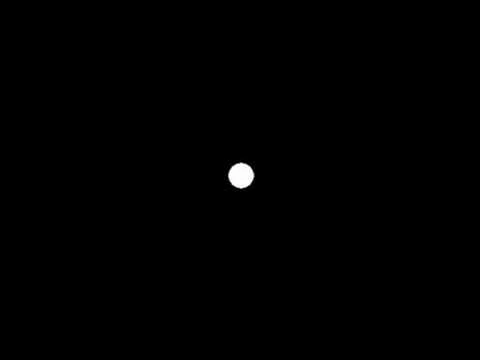

The Autokinetic Effect
We know the brain loves a good optical illusion. When our brain and eyes work together to interpret what we see, often it tricks us into thinking things are moving around. The autokinetic effect can make stationary objects seem as if they are moving in the dark. Some UFO sightings could be attributed to this phenomenon. So let's look at the autokinetic effect in more detail.
What is the autokinetic effect?
Also known as autokinesis, this phenomenon occurs when a small stationary source of light that is surrounded by a dark environment appears to be moving. It actually isn't moving, but there are scenarios where we believe it is moving. It is thought that because it is surrounded by darkness, there is no reference point for our brains to use. The jury is out as to whether it is more a fault of the eye or the brain. While some believe it has to do with how the brain perceives the information, others believe it is more to do with involuntary eye movements.

Conformity and autokinesis
Conformity is best described as the power of suggestion in way. It is a social influence that makes a person change their belief or behaviour to align with those around them. Turkish American social psychologist Muzafer Sherif actually used autokinesis to demonstrate how a person can be influenced by another person's opinion. Using a small light projected on a dark screen in a controlled environment, the participants were asked to guess how far the light moved (such as from 20-80cm). They then put subjects in three groups to be tested again. He purposely put 2 people in a group who guessed a similar figure and then one person whose guess was considerably different. Each person in the group had to state out aloud how far they thought the light had moved. Over several trials, each member of the group came up with a similar figure meaning in each case, the person whose guess was initially vastly different to the rest of the group changed their mind. He concluded that in group situations, people are more likely to conform than make an individual judgment. When in an ambiguous situation, a person unknowingly looks to their peers to help them to make a judgment.
How does this apply to UFOs?
In 1799 Alexander Von Humboldt who was a geographer and explorer was staring up at the sky as he usually did. He noticed that some of the stars seemed to be moving. He labelled this movement "Sternschwanken: which means moving stars in German. It wasn't until 58 years later that a German psychologist realized that it wasn't that the stars were moving, it was the brain perceiving the movement. In many cases of searching for UFO phenomena, people will conduct a 'sky watch' which often involves sitting outside and staring at the sky for hours on end. While equipment is also often used, a person is likely looking at the sky using their eyes. This is the perfect scenario for autokinesis to occur. You have a bright light source being a star, and a dark surrounding background being the night sky. If you are with another person and you comment 'Do you see that light moving in the sky?', conformity could make them think they are seeing this same movement. The good news is that video is immune to this phenomenon because well a video doesn't have a brain. It is an unbias account of what is happening. If you see an item moving in the sky, refer straight back to your video to see if it moves. It is a good control to see if it is just a case of your eyes playing tricks on you. To avoid autokinesis, it is suggested not to just focus on one particular area with your eyesight and to often scan different areas with your eyes.
There is a lot to look at when you simply take the time to look up and see the stars. From shooting stars, aeroplanes and satellites, it takes an avid skywatcher to know what they are looking for. Like anything, practice makes perfect and it is something you will only learn after you go out and do it. If in doubt, remember a camera doesn't lie. Try to have a static camera set up that you refer to confirm if a moving object you saw was really a moving object or just autokinesis. It can also apply during a paranormal investigation as well.
Paranormal investigating
Often people think they can see a light fixture swinging or a door moving, yet upon inspection, they realize it hasn't moved at all. I know when I am at Black Rock House, in the kitchen it is quite dark with a small light source coming from a window. It always looks like the boxes hanging from the roof are moving. Often a person may comment 'look it is moving' and suddenly we all agree that it looks like it is moving. Upon review of the video, it wasn't moving at all - our eyes were playing tricks on us. As paranormal investigators, we love investigating in the dark, so we need to make sure that we know that not everything we are experiencing in the dark is as it seems. When you start playing or depriving a person's senses, the brain tries to fill in the gaps.
A video camera again will be able to show you if the door or light fixture really was moving or if it was your eyes playing a trick on you! When you can eliminate this optical illusion, then the real fun of working out what you really saw begins!
If you enjoy LLIFS, consider buying me a book (otherwise known as buy me a coffee but I don't drink coffee and I LOVE books). Your donation helps to fund the LLIFS website so everyone can continue to access great paranormal content and resources for FREE!

Top pages with similar subjects
Don't forget to follow the Facebook page for regular updates
Join the mailing list to receive weekly updates of NEW articles. Never miss an article again!
Buy the latest and past issues Haunted Magazine
Check out the books written by LLIFS
Comments
-
Joseph Kapusta 5 years ago
To this day, just for the point of scientific acknowledgement, I duplicate this phenomena easily just about every night as I go to bed. In my darkened bedroom where the door to the adjacent room has been left open approximately six inches, and the light traces a path onto the bedroom ceiling (the adjoining room is lit faintly but sufficient to see for navigation), I find I can simply open my eyes after having closed them for a few seconds, and the gap of light projected onto the ceiling from the adjacent room instantly appears to move as if growing smaller like the door closing for several pronounced inches and then abruptly stopping! To me, this confirms the belief the phenomena is linked to eye muscle motor movement and additionally, fatigue in those muscles. Amusingly, I can picture a novice ghost hunter unfamiliar with this effect causing them to freak out under favorable conditions to replicate these conditions and swearing they witnessed the door start to close all on its own.